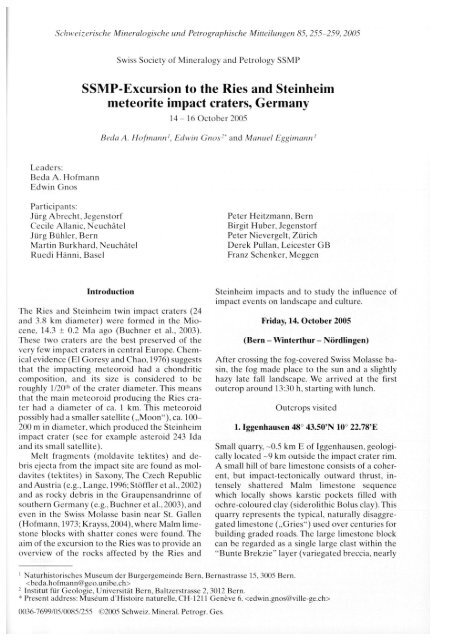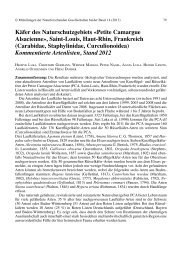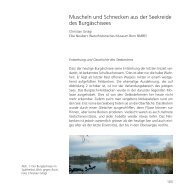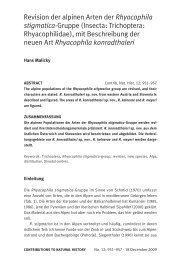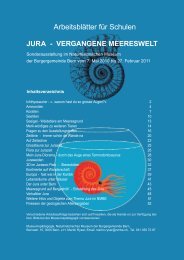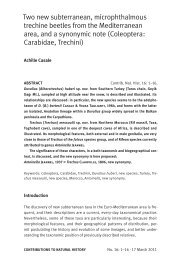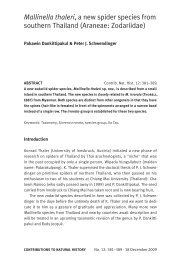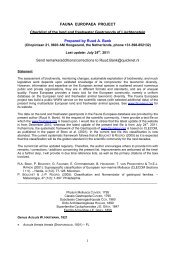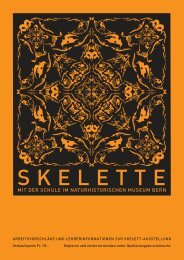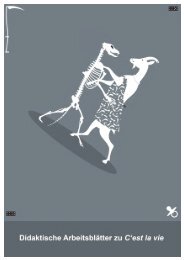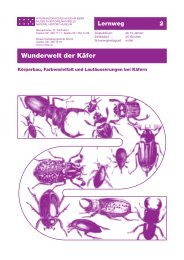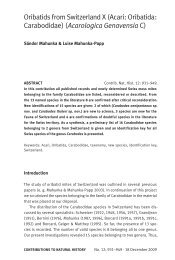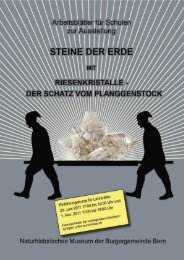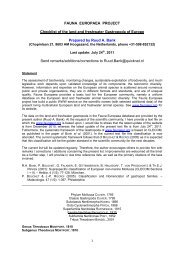PDF-Export ETH-Konsortium: Dokumente - Naturhistorisches ...
PDF-Export ETH-Konsortium: Dokumente - Naturhistorisches ...
PDF-Export ETH-Konsortium: Dokumente - Naturhistorisches ...
You also want an ePaper? Increase the reach of your titles
YUMPU automatically turns print PDFs into web optimized ePapers that Google loves.
Schweizerische Mineralogische und Petrographische Mitteilungen 85, 255-259, 2005<br />
Leaders:<br />
Beda A. Hofmann<br />
Edwin Gnos<br />
Swiss Society of Mineralogy and Petrology SSMP<br />
SSMP-Excursion to the Ries and Steinheim<br />
meteorite impact craters, Germany<br />
Participants:<br />
Jürg Abrecht, Jegenstorf<br />
Cecile Allanic, Neuchätel<br />
Jürg Bühler, Bern<br />
Martin Burkhard, Neuchätel<br />
Ruedi Hänni. Basel<br />
14-16 October 2005<br />
Beda A. Hofmann1, Edwin Gnos2' and Manuel Eggimann'<br />
Introdüction<br />
The Ries and Steinheim twin impact craters (24<br />
and 3.8 km diameter) were formed in the Mio¬<br />
cene. 14.3 ± 0.2 Ma ago (Buchner et al., 2003).<br />
These two craters are the best preserved of the<br />
very few impact craters in central Europe. Chem¬<br />
ical evidence (El Goresy and Chao, 1976) suggests<br />
that the impacting meteoroid had a chondritic<br />
composition, and its size is considered to be<br />
roughly l/2(),h of the crater diameter. This means<br />
that the main meteoroid producing the Ries cra¬<br />
ter had a diameter of ca. 1 km. This meteoroid<br />
possibly had a smaller satellite (Moon"), ca. 100-<br />
200 m in diameter. which produced the Steinheim<br />
impact crater (see for example asteroid 243 Ida<br />
and its small satellite).<br />
Melt fragments (moldavite tektites) and de¬<br />
bris ejecta from the impact site are found as moldavites<br />
(tektites) in Saxony, The Czech Republic<br />
and Austria (e.g.. Lange, 1996; Stöffler et al., 2002)<br />
and as rocky debris in the Graupensandrinne of<br />
southern Germany (e.g.. Buchner etal., 2003), and<br />
even in the Swiss Molasse basin near St. Gallen<br />
(Hofmann. 1973; Krayss, 2004), where Malm lime¬<br />
stone blocks with shatter cones were found. The<br />
aim of the excursion to the Ries was to provide an<br />
overview of the rocks affected by the Ries and<br />
1<br />
Peter Heitzmann, Bern<br />
Birgit Huber. Jegenstorf<br />
Peter Nievergelt, Zürich<br />
Derek Pullan, Leicester GB<br />
Franz Schenker. Meggen<br />
<strong>Naturhistorisches</strong> Museum der Burgergemeinde Bern. Bernastrasse 15. 3005 Bern.<br />
<br />
Steinheim impacts and to study the influence of<br />
impact events on landscape and culture.<br />
Friday, 14. October 2005<br />
(Bern - Winterthur - Nördlingen)<br />
After crossing the fog-covered Swiss Molasse ba¬<br />
sin, the fog made place to the sun and a slightly<br />
hazy late fall landscape. We arrived at the first<br />
outcrop around 13:30 h, starting with lunch.<br />
Outcrops visited<br />
1. Iggenhausen 48° 43.50'N 10° 22.78'E<br />
Small quarry, -0.5 km E of Iggenhausen, geologically<br />
located -9 km outside the impact crater rim.<br />
A small hill of bare limestone consists of a coher¬<br />
ent, but impact-tectonically outward thrust, in¬<br />
tensely shattered Malm limestone sequence<br />
which locally shows karstic pockets filled with<br />
ochre-coloured clay (siderolithic Bolus clay).This<br />
quarry represents the typical, naturally disaggregated<br />
limestone (Gries") used over centuries for<br />
building graded roads. The large limestonc block<br />
can be regarded as a single large clast within the<br />
"Bunte Brekzie" layer (variegated breccia, nearly<br />
- Institut für Geologie. Universität Bern. Baltzerstrasse 2.3012 Bern.<br />
* Present address: Museum d'Histoire naturelle. CH-1211 Geneve 6. <br />
0036-7699/05/0085/255 ©2005 Schweiz. Mineral. Petrogr. Ges.


